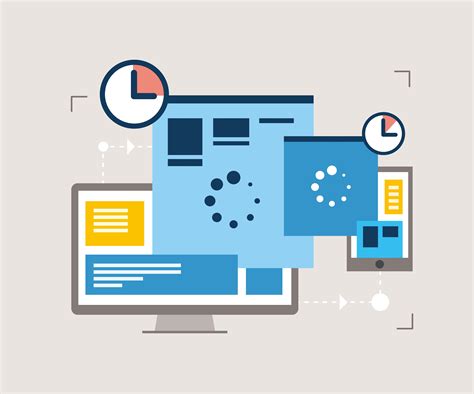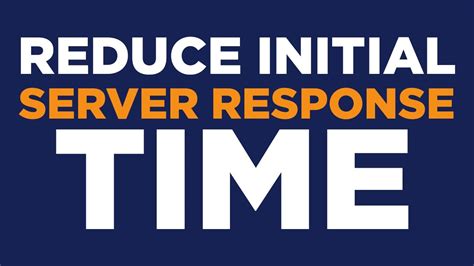In today's digital era, where attention spans are shrinking and competition is fierce, every second counts when it comes to website loading time. Your website's performance is not only crucial for user experience, but it also directly impacts your search engine rankings. Slow loading speed can drive away visitors and affect your business's bottom line.
Fortunately, there are several proven strategies you can employ to boost your website's loading time and deliver a seamless browsing experience to your users. By implementing effective optimization techniques, you can ensure that your website loads swiftly, grabs users' attention, and keeps them engaged.
Streamlining server response is one fundamental aspect of optimizing your website's loading speed. By reducing the time taken for the server to respond to a request, you can significantly enhance the overall performance. This can be achieved by fine-tuning server configurations, minimizing redirects, and utilizing caching systems.
Compressing resources is another key technique that can have a significant impact on your website's loading speed. With the help of advanced compression algorithms, you can reduce the size of files such as images, CSS, and JavaScript without sacrificing their quality. This not only speeds up the loading time but also reduces bandwidth consumption, making your website more cost-effective.
Optimize Images for Web

In today's digital landscape, it is crucial to ensure that images displayed on a website are optimized for web usage. By optimizing images, webpages can load faster and improve the overall user experience. This section will explore various techniques and best practices for optimizing images without compromising their quality and visual appeal.
1. Choose the right image format: Different image formats offer varying levels of compression and are suitable for different types of images. Opt for JPEG format for photographs and complex images, PNG format for images with transparency, and SVG format for vector graphics.
2. Resize and crop images: Before uploading images to a website, it is important to resize and crop them to the correct dimensions. This helps reduce file size and prevents unnecessary bandwidth consumption.
3. Compress images: Utilize image compression tools or software to reduce the file size of images without compromising their visual quality. This can be achieved through lossless compression techniques or by adjusting the image quality level.
4. Lazy loading: Implement lazy loading techniques for images, where images are only loaded when they are visible within the user's viewport. This can significantly reduce the initial load time of a webpage, especially when there are numerous images present.
5. Use responsive images: Ensure that images are responsive and adapt to different screen sizes and resolutions. This can be achieved through the use of CSS media queries and responsive image techniques.
6. Specify image dimensions: Specify the width and height attributes of images in HTML. This allows the browser to allocate the appropriate space for the image, preventing layout shifting and reducing page reflows.
7. Use image CDNs: Utilize content delivery networks (CDNs) specifically designed for delivering images. CDNs help deliver images from servers located close to the user, reducing latency and improving loading times.
By implementing these optimization techniques, images on a website can be highly optimized for web usage, resulting in faster loading times and an enhanced user experience.
Optimize CSS and JavaScript Files
Enhancing the performance of your website involves various techniques, and one effective way to boost its loading speed is by minifying CSS and JavaScript files. Minification refers to the process of compressing and optimizing these files to reduce their size and improve their loading time. By removing unnecessary characters, spaces, and line breaks, you can significantly optimize your website's CSS and JavaScript files.
Minifying CSS and JavaScript files offers several benefits. Firstly, it reduces the overall file size, resulting in faster download times. These optimized files are also easier to transmit from the server to the user's browser, minimizing latency and enhancing the browsing experience. Moreover, minification helps reduce bandwidth usage, especially for users accessing your website on mobile devices or with limited data plans.
To minify your CSS and JavaScript files, you can utilize various tools and techniques. One common approach is by employing online minification services or using dedicated software. These tools analyze and reformat your files, removing unnecessary characters and optimizing the code structure. Additionally, you can manually minify your files by removing unnecessary comments, whitespace, and line breaks. However, this method requires careful attention to avoid altering the functionality of your code.
Another technique to optimize your CSS and JavaScript files is by combining multiple files into a single file. By merging CSS and JavaScript files, you reduce the number of HTTP requests required to load your website, resulting in improved loading speed. However, it's essential to ensure that the combined files remain organized and do not interfere with the functionality of your website.
Regularly updating and revisiting your CSS and JavaScript files is also crucial for maintaining optimal performance. As your website evolves, it's common for these files to accumulate unnecessary code or become outdated. By removing unused code and implementing best practices, you can continually improve the efficiency and loading speed of your website.
In conclusion, minifying CSS and JavaScript files is a valuable technique for boosting your website's loading speed. By compressing and optimizing these files, you can reduce their size, enhance download times, and provide an improved browsing experience for your users.
Utilize Content Delivery Networks (CDN)

Increase the loading speed and optimize your website's performance by implementing Content Delivery Networks (CDN). Enhance the delivery of your web content to users around the globe without relying solely on your website's hosting server.
By utilizing CDN services, you can ensure that your website's content is distributed across multiple servers strategically located in different geographical regions. These servers, known as CDN edge servers or points of presence (PoPs), are located closer to the end-users. This proximity significantly reduces the latency and improves the overall loading speed of your website.
- Geographically Distributed Network: CDN networks consist of numerous strategically placed servers across different regions, providing global coverage. It allows users to access your website's content from a server located nearest to their location, resulting in faster loading times.
- Load Balancing: CDN automatically redirects user requests to the nearest edge server, distributing the load across multiple servers. This load balancing technique evenly distributes the traffic, reduces server load, and ensures faster response times.
- Caching: CDN caches your website's static content on its edge servers, eliminating the need to fetch data from the origin server each time a user requests it. This caching mechanism reduces server load and significantly improves the loading speed, resulting in a seamless user experience.
Implementing a CDN involves configuring your website to route its traffic through the CDN provider's system. This process requires setting up DNS records, modifying the website's URLs, and configuring caching rules. CDNs offer various pricing plans, allowing businesses of all sizes to benefit from their services.
Overall, implementing a CDN can greatly enhance your website's loading speed by reducing latency, optimizing content delivery, and improving user experience. By leveraging the power of a geographically distributed network, load balancing, and caching mechanisms, CDNs play a crucial role in delivering web content efficiently.
Improving Website Performance with Caching
In this section, we will explore the concept of caching and its role in enhancing the overall performance of a website. Caching involves storing frequently accessed data, such as web pages and images, in a temporary storage location, so that subsequent requests for the same data can be served faster. By enabling caching on your website, you can optimize load times, reduce server load, and provide a better user experience.
One key benefit of caching is the reduction in server requests. When a user visits a website, their browser sends a request to the server to retrieve the necessary files. With caching enabled, instead of retrieving the same files repeatedly, the browser can use the locally stored cached versions, resulting in faster page load times. This not only improves the overall speed and performance of the website but also reduces the strain on the server.
To enable caching, you can utilize various techniques such as setting cache headers and utilizing browser caching. Cache headers allow you to define how long specific resources should be cached by the browser. By setting appropriate cache durations for different file types, you can strike a balance between serving up-to-date content and minimizing server requests.
Browser caching, on the other hand, involves configuring the server to indicate to the browser that certain resources can be stored locally. This allows the browser to retrieve those resources from its cache rather than making additional requests to the server. By leveraging browser caching, you can significantly improve the loading speed of your website for returning visitors.
Another caching technique worth considering is the use of Content Delivery Networks (CDNs). CDNs are a network of servers distributed around the world that store cached copies of your website's content. When a user requests your website, the CDN server closest to them can deliver the cached content, resulting in reduced latency and faster load times.
In conclusion, enabling caching on your website is an effective method to enhance its performance by reducing server requests, optimizing load times, and providing a better user experience. By implementing cache headers, utilizing browser caching, and considering the use of CDNs, you can significantly boost your website's loading speed and improve overall performance.
Reduce Server Response Time

One crucial factor in improving website performance is reducing server response time. This refers to the time it takes for a server to respond to a request from a user's browser. A faster server response time can lead to quicker loading speeds and a smoother browsing experience for visitors.
To minimize server response time, there are several strategies that can be implemented. First, optimizing database queries and ensuring efficient code execution can help reduce the time it takes for the server to process and retrieve requested data. This involves identifying and resolving any bottlenecks or inefficiencies in the codebase.
Caching is another effective method for reducing server response time. By storing commonly accessed data in cache memory, subsequent requests for the same data can be served directly from the cache instead of retrieving it from the server. This can significantly reduce the overall response time and improve website performance.
Additionally, utilizing a content delivery network (CDN) can help reduce server response time by distributing content across multiple servers located in different geographical regions. This allows users to access the content from a server that is physically closer to them, resulting in faster response times.
Regular monitoring and performance testing are essential in identifying any potential server response time issues. By analyzing metrics and logs, you can identify areas for improvement and implement necessary optimizations to further reduce server response time.
- Optimize database queries
- Evaluate code efficiency
- Implement caching techniques
- Utilize a content delivery network (CDN)
- Monitor and analyze performance metrics
By focusing on reducing server response time, websites can enhance their overall performance and provide users with a faster and more seamless browsing experience.
FAQ
Why is website loading speed important?
Website loading speed is important because it directly affects user experience. A slow-loading website can frustrate visitors and make them abandon the site, leading to a high bounce rate. Additionally, search engines like Google consider website loading speed as a ranking factor, so a slow website can negatively impact your search engine rankings.
What are some effective methods to boost website loading speed?
There are several effective methods to boost website loading speed. One is optimizing images by compressing them and using appropriate file formats. Another method is minimizing the use of external scripts and CSS files to reduce the number of HTTP requests. Implementing caching techniques and using a content delivery network (CDN) can also significantly improve loading speed.
How does image optimization affect website loading speed?
Image optimization plays a crucial role in website loading speed. By compressing images without significant loss in quality and using the appropriate file formats (such as JPEG, PNG, or WebP), the file sizes can be significantly reduced. This allows the images to load faster, resulting in improved website loading speed.
What is caching and how can it help speed up a website?
Caching is the process of storing static versions of web pages or certain elements of a website in order to serve them more quickly to users. By caching, the server can deliver the requested content without having to generate it again, thus significantly reducing the loading time. This is particularly useful for frequently visited pages or elements that do not change often.
Why is the use of a content delivery network (CDN) beneficial for website loading speed?
A CDN is beneficial for website loading speed because it distributes the website's static content across multiple servers located in different geographic locations. When a user requests to access the website, the server closest to the user can deliver the content, reducing the latency and improving the loading speed. This also helps to handle high traffic situations and improves the overall reliability and scalability of the website.
Why is website loading speed important?
Website loading speed is important because it affects user experience. A slow-loading website can lead to high bounce rates and lower conversions. Additionally, search engines consider website speed as a ranking factor, so a slow site may be ranked lower in search engine results.
What are some common factors that can slow down website loading speed?
There are several factors that can slow down website loading speed. Some common ones include large image or file sizes, excessive HTTP requests, inefficient code, lack of browser caching, and slow server response times. All these factors can contribute to a slow-loading website.



